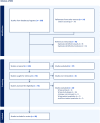Preoperative mapping techniques for brain tumor surgery: a systematic review
- PMID: 39839770
- PMCID: PMC11747149
- DOI: 10.3389/fonc.2024.1481430
Preoperative mapping techniques for brain tumor surgery: a systematic review
Abstract
Accurate preoperative mapping is crucial for maximizing tumor removal while minimizing damage to critical brain functions during brain tumor surgery. Navigated transcranial magnetic stimulation (nTMS), magnetoencephalography (MEG), and functional magnetic resonance imaging (fMRI) are established methods for assessing motor and language function. Following PRISMA guidelines, this systematic review analyzes the reliability, clinical utility, and accessibility of these techniques. A total of 128 studies (48 nTMS, 56 fMRI, 24 MEG) were identified from various databases. The analysis finds nTMS to be a safe, standardized method with high accuracy compared to direct cortical stimulation for preoperative motor mapping. Combining nTMS with tractography allows for preoperative assessment of short-term and long-term motor deficits, which may not be possible with fMRI. fMRI data interpretation requires careful consideration of co-activated, non-essential areas (potentially leading to false positives) and situations where neural activity and blood flow are uncoupled (potentially leading to false negatives). These limitations restrict fMRI's role in preoperative planning for both motor and language functions. While MEG offers high accuracy in motor mapping, its high cost and technical complexity contribute to the limited number of available studies. Studies comparing preoperative language mapping techniques with direct cortical stimulation show significant variability across all methods, highlighting the need for larger, multicenter studies for validation. Repetitive nTMS speech mapping offers valuable negative predictive value, allowing clinicians to evaluate whether a patient should undergo awake or asleep surgery. Language function monitoring heavily relies on the specific expertise and experience available at each center, making it challenging to establish general recommendations.
Keywords: brain mapping; brain tumor surgery; fMRI; language eloquent tumor; magnetoencephalography (MEG); motor eloquent tumors; navigated transcranial magnetic stimulation (nTMS); preoperative mapping.
Copyright © 2025 Leone, Carbone, Spetzger, Vajkoczy, Raffa, Angileri, Germanó, Engelhardt, Picht, Colamaria and Rosenstock.
Conflict of interest statement
The authors declare that the research was conducted in the absence of any commercial or financial relationships that could be construed as a potential conflict of interest.
Figures






Similar articles
-
Setup presentation and clinical outcome analysis of treating highly language-eloquent gliomas via preoperative navigated transcranial magnetic stimulation and tractography.Neurosurg Focus. 2018 Jun;44(6):E2. doi: 10.3171/2018.3.FOCUS1838. Neurosurg Focus. 2018. PMID: 29852769
-
When imaging meets neurophysiology: the value of navigated transcranial magnetic stimulation for preoperative neurophysiological mapping prior to brain tumor surgery.Neurosurg Focus. 2019 Dec 1;47(6):E10. doi: 10.3171/2019.9.FOCUS19640. Neurosurg Focus. 2019. PMID: 31786549
-
Surgery of language-eloquent tumors in patients not eligible for awake surgery: the impact of a protocol based on navigated transcranial magnetic stimulation on presurgical planning and language outcome, with evidence of tumor-induced intra-hemispheric plasticity.Clin Neurol Neurosurg. 2018 May;168:127-139. doi: 10.1016/j.clineuro.2018.03.009. Epub 2018 Mar 11. Clin Neurol Neurosurg. 2018. PMID: 29549813
-
Preoperative Applications of Navigated Transcranial Magnetic Stimulation.Front Neurol. 2021 Jan 22;11:628903. doi: 10.3389/fneur.2020.628903. eCollection 2020. Front Neurol. 2021. PMID: 33551983 Free PMC article. Review.
-
Navigated Transcranial Magnetic Stimulation Motor Mapping Usefulness in the Surgical Management of Patients Affected by Brain Tumors in Eloquent Areas: A Systematic Review and Meta-Analysis.Front Neurol. 2021 Mar 4;12:644198. doi: 10.3389/fneur.2021.644198. eCollection 2021. Front Neurol. 2021. PMID: 33746895 Free PMC article.
Cited by
-
Virtual Biopsy for the Prediction of MGMT Promoter Methylation in Gliomas: A Comprehensive Review of Radiomics and Deep Learning Approaches Applied to MRI.Diagnostics (Basel). 2025 Jan 22;15(3):251. doi: 10.3390/diagnostics15030251. Diagnostics (Basel). 2025. PMID: 39941181 Free PMC article. Review.
-
Real-Time Object Detector for Medical Diagnostics (RTMDet): A High-Performance Deep Learning Model for Brain Tumor Diagnosis.Bioengineering (Basel). 2025 Mar 11;12(3):274. doi: 10.3390/bioengineering12030274. Bioengineering (Basel). 2025. PMID: 40150738 Free PMC article.
References
-
- Almenawer SA, Badhiwala JH, Alhazzani W, Greenspoon J, Farrokhyar F, Yarascavitch B, et al. . Biopsy versus partial versus gross total resection in older patients with high-grade glioma: a systematic review and meta-analysis. Neuro-Oncol. (2015) 17:868–81. doi: 10.1093/neuonc/nou349 - DOI - PMC - PubMed
Publication types
LinkOut - more resources
Full Text Sources

